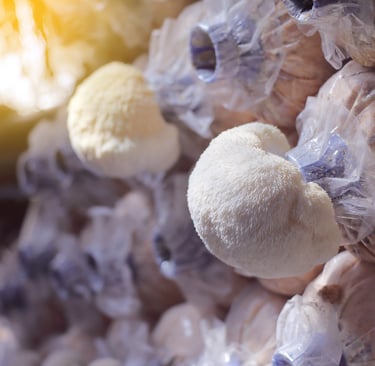From Ancient Wisdom to Modern Wellness: The Journey of Lion’s Mane Mushroom
EN
1/2/20252 min lesen


When you think of a mushroom, you might picture the standard button variety or maybe a whimsical toadstool from a fairy tale. But Lion’s Mane? This fluffy, white fungus looks more like a tiny, mystical waterfall growing on the side of a tree than your typical mushroom. Its history is just as fascinating as its appearance, stretching back thousands of years to ancient cultures that revered it not just as food but as medicine and even a source of spiritual insight.
Ancient Beginnings
Lion’s Mane (scientifically known as Hericium erinaceus) has roots in Traditional Chinese Medicine (TCM), where it’s been celebrated for centuries. Ancient healers called it “Hou Tou Gu,” and it was prized for its ability to enhance digestion and strengthen the spleen. But its appeal wasn’t just physical. Buddhist monks were said to consume Lion’s Mane as part of their diet, believing it supported mental clarity and helped them achieve a meditative state. Imagine sitting in a serene monastery with this brain-boosting mushroom as your secret weapon for enlightenment!
In Japan, Lion’s Mane is known as “Yamabushitake,” named after the Yamabushi monks who trekked through mountainous regions. These monks believed the mushroom’s ethereal appearance mirrored their spiritual practices, blending mind and body harmony with nature.
A Forgotten Treasure in the West
For much of history, the wonders of Lion’s Mane were confined to Asia. In the West, mushrooms weren’t exactly hailed for their health benefits. Instead, they were often regarded as a curious culinary ingredient or, occasionally, feared as potential poison. It wasn’t until the late 20th century that Lion’s Mane began capturing the attention of Western researchers and health enthusiasts.
What changed? Science. Researchers discovered Lion’s Mane wasn’t just a folklore hero. It’s packed with compounds called hericenones and erinacines, which are believed to support nerve regeneration and brain health. This was groundbreaking—a mushroom that could potentially enhance memory, concentration, and even combat neurodegenerative diseases like Alzheimer’s? Suddenly, Lion’s Mane became more than a mysterious fungus; it was a superstar in the making.
The Modern Revival
Today, Lion’s Mane has surged in popularity, and for good reason. Whether you’re a biohacker, a wellness enthusiast, or just someone looking to feel sharper during the morning Zoom meeting, Lion’s Mane has become a go-to supplement. It’s available in everything from capsules to powders and even coffees, allowing you to easily incorporate it into your daily routine.
And it’s not just about brain health. Recent studies hint at its potential to boost immunity, support gut health, and even combat anxiety and depression. Plus, with the rise of plant-based diets, Lion’s Mane has found a new niche in the culinary world. Its meaty texture and subtle seafood-like flavor make it a star ingredient in vegan crab cakes and stir-fries.
The Takeaway
Lion’s Mane isn’t just a mushroom; it’s a bridge between ancient traditions and modern wellness. From the serene monasteries of East Asia to the bustling health food stores of today, this remarkable fungus has proven that sometimes, nature’s strangest creations hold the most extraordinary potential.
So, whether you’re sipping a Lion’s Mane latte or diving into its fascinating history, take a moment to appreciate how far this fluffy fungus has come. After all, it’s not every day you meet a mushroom with a 1,000-year-old legacy that’s still making waves in the 21st century!
Rechtliches
Lebensmittelunternehmer Nr. 130023176
Vilnius, Litauen
Über uns
Fungu Forest ist ein kleines Unternehmen, das in der EU hergestellte Pilz- und Kräuterextrakte und Nahrungsergänzungsmittel vertreibt.
